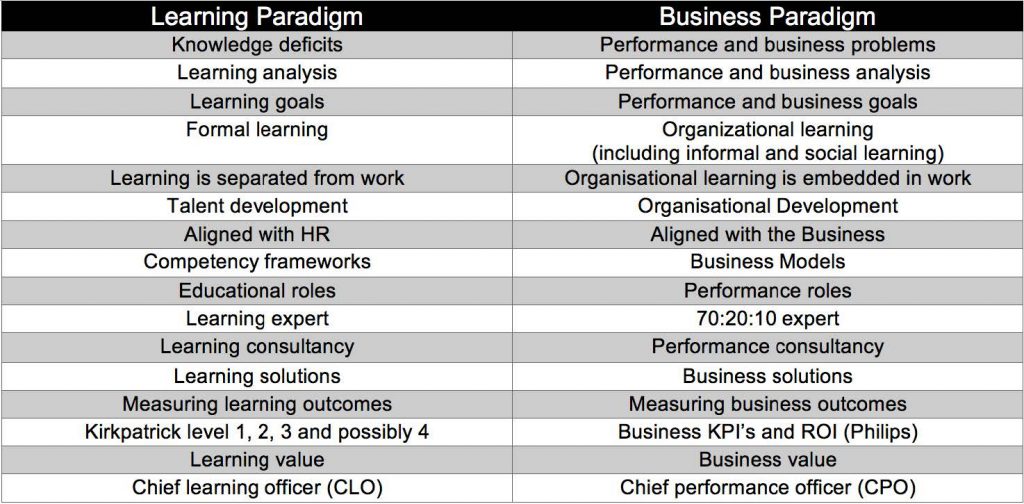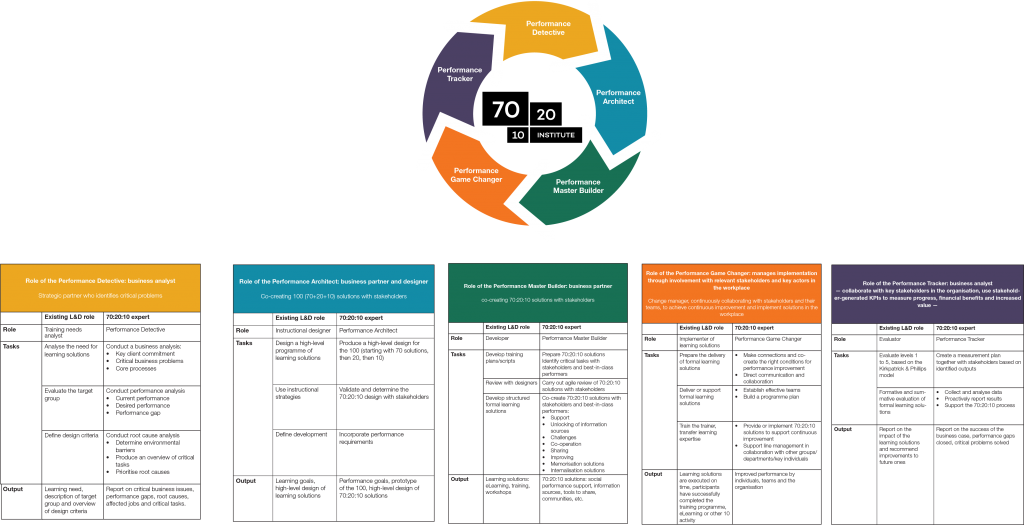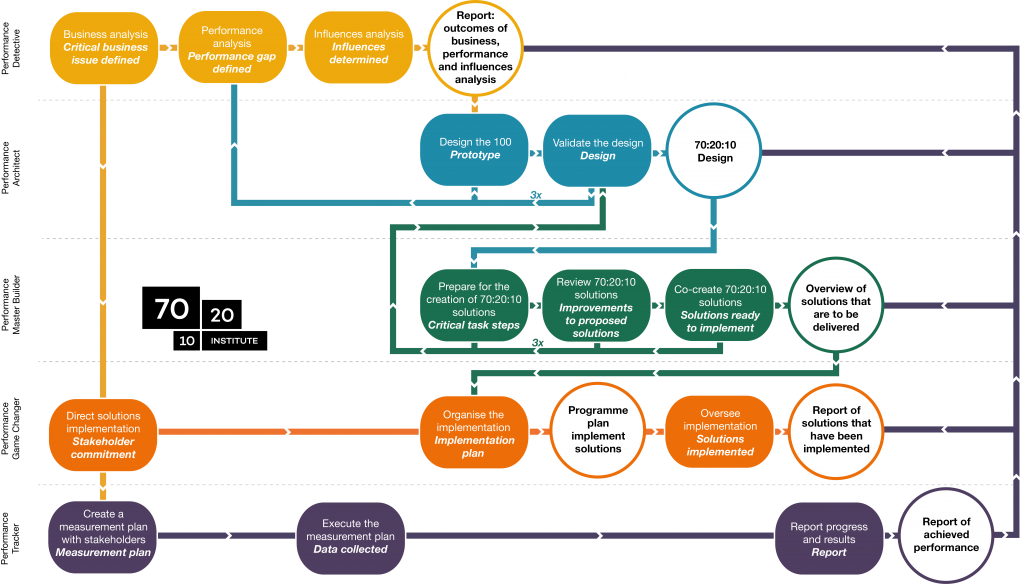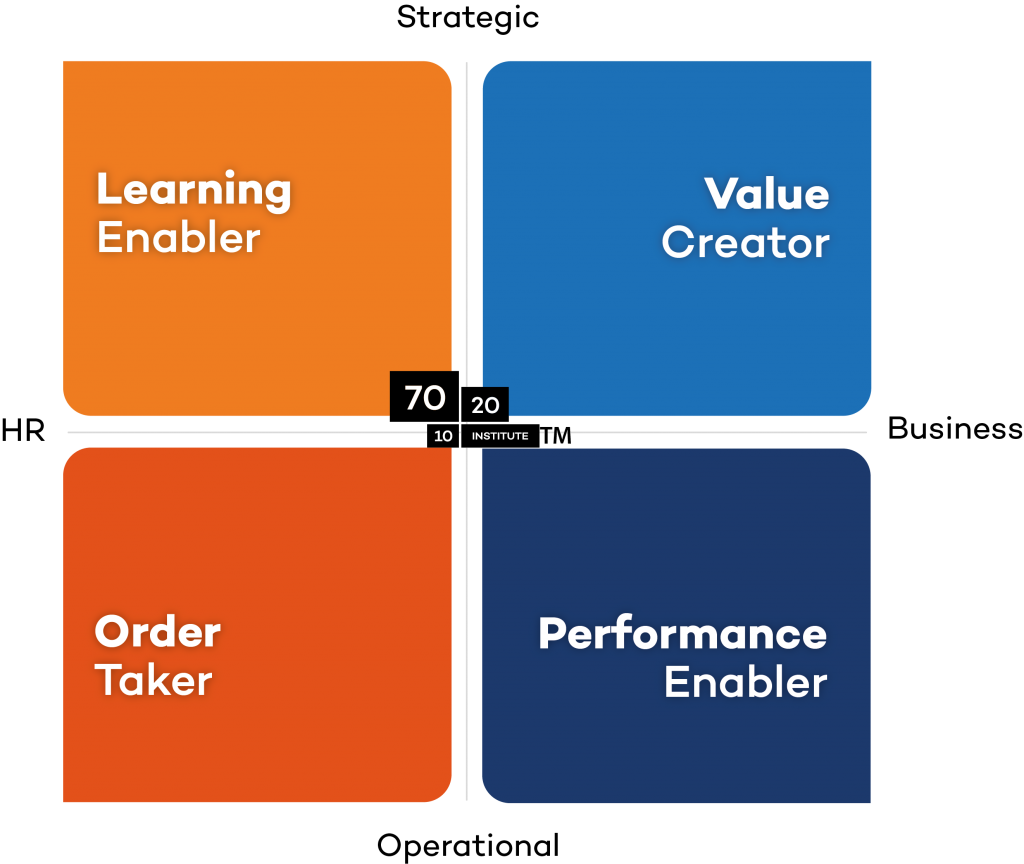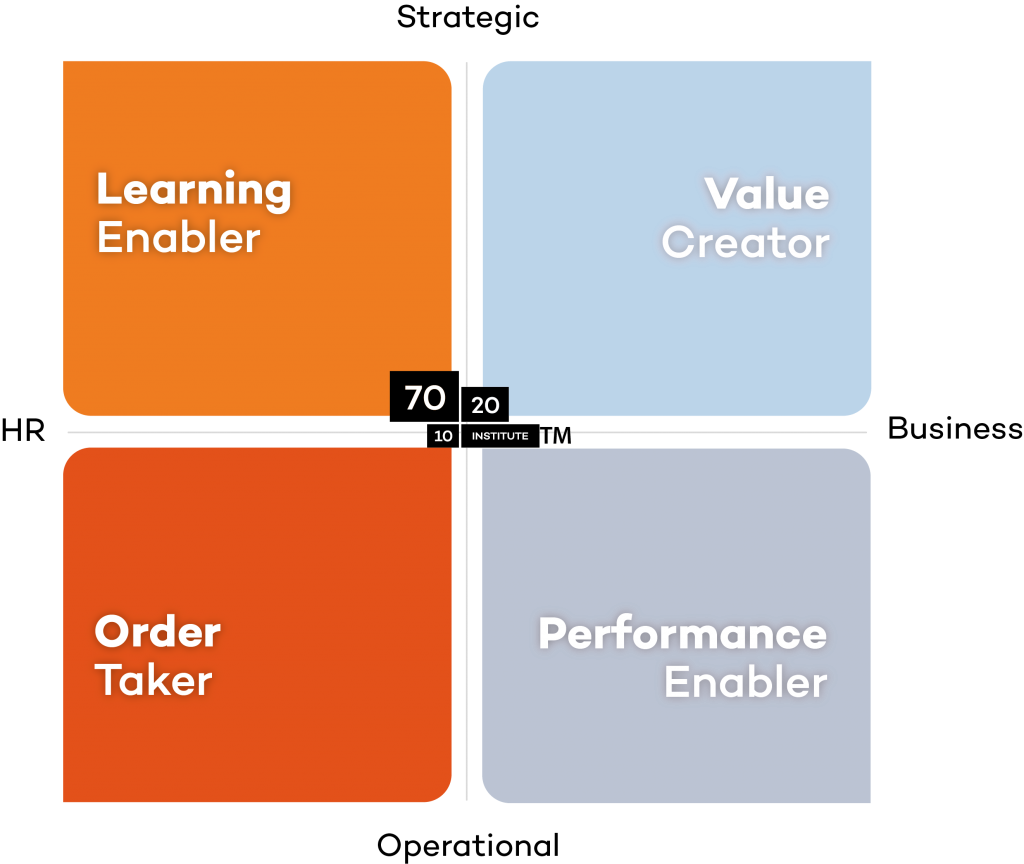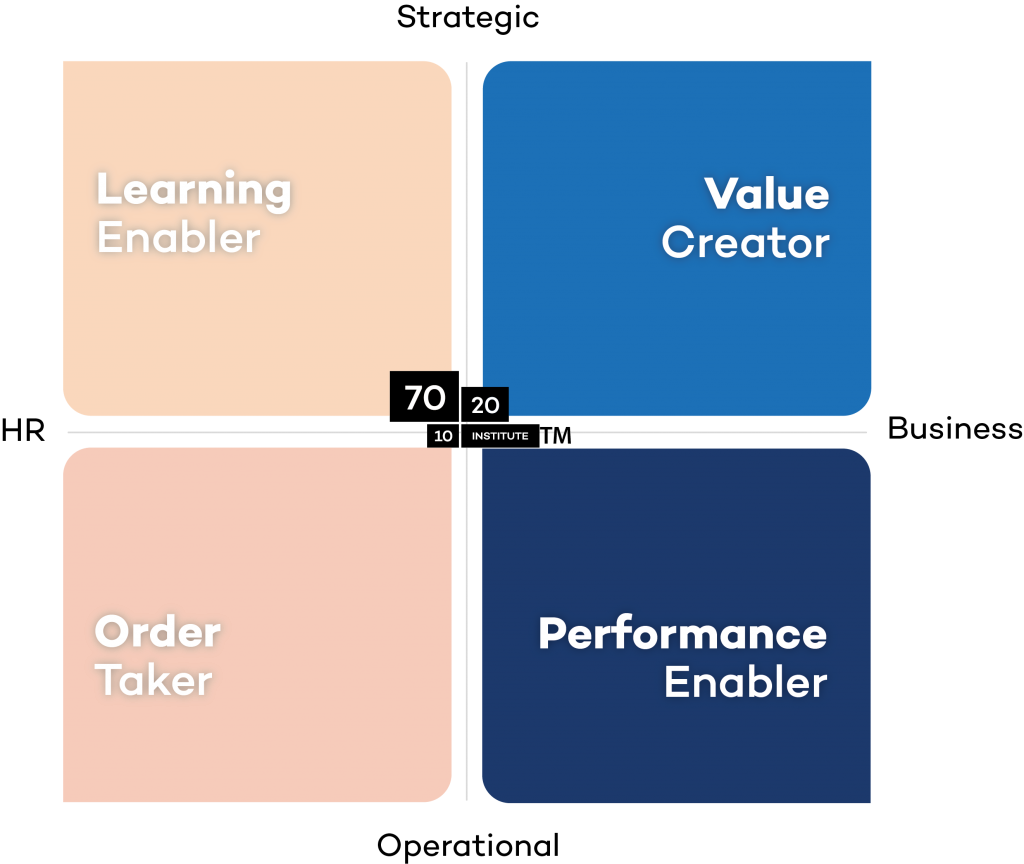If you’re not at the table, you’re on the menu
For many years, Learning and Development (L&D) has been trying to demonstrate the value of learning. It has modernised the services it provides, reorganised its distribution methods for greater efficiency, and professionalised its measurement processes. But it is still failing. This raises some important questions: should we continue to focus on learning value? Or is this the time to redefine the future of L&D and focus on business value? This paper takes a closer look at how L&D can have a ‘seat at the table’ instead of simply being on the menu, by using the Business Models approach.
L&D under stress?
In recent years, all kinds of trend reports and articles have been published that carry strong signals demonstrating that L&D is generally not working well in organizations.
Smith (2017) sees the problem in this way, when looking at the current state of L&D and its view of its responsibilities, ‘Saying the responsibility for learning doesn’t belong to L&D feels like saying medicine doesn’t belong with doctors or hi-tech doesn’t belong in Silicon Valley.’
The Deloitte study, titled ‘adapt workplace learning to the speed of business’ presents an alarm signal for L&D: Seventy-four percent of organizations surveyed focus primarily on traditional learning methods that can fall short of empowering employees to acquire skills to keep pace with change and improve the work itself. (Deloitte, 2017)
Therefore, it is not surprising for Josh Bersin (2017) to state: ‘In the 15 years I’ve been studying corporate L&D, I haven’t seen the industry under so much stress. We are in a disruptive time, forcing companies of all sizes to literally reinvent their entire learning strategy, infrastructure and employee experience like never before.’
According to Dillon (2017), an evolution is insufficient to improve the L&D function. A transformation is necessary: ‘Kick-starting the transformation to become a modern learning organization requires a fundamental mindset shift. Rather than put our library at the center of our efforts, we must shift our focus to the individual employee and design a right-fit learning and support experience that enables organizational goals.’
Over the past decades, L&D has been busy trying to demonstrate the value of learning. However, this is no longer seen as being sufficient nor relevant. Learning in organizations is intended to improve performance measurably. Simply measuring the process without measuring the results will not provide insight into realized value. This is one reason the interest to demonstrate business impact is so high in L&D.
In our view, demonstrating impact is impossible if L&D fails to realign its service from a focus on the learning paradigm to a focus on the business paradigm. For this to happen, L&D needs to extend beyond the exclusive offering of formal learning solutions. (Arets, Jennings, Heijnen, 2015)
It is impossible to connect learning to the business if learning and working are separated from each other.
Optimally, there is a need for a consistent process of reevaluation and deduction to determine the best solutions to deliver the desired organisational results. For this to occur, it is necessary to stop seeing formal learning as the basis of the L&D service.
L&D needs to embrace a culture of supporting learning by doing’.
From an economic point of view, learning by doing always involves organizational learning when people are working to improve productivity. (Stiglitz, 2014, De Grip, 2015).
The opportunities for L&D to change, and to remain relevant, lie in discarding the learning paradigm and adopting the business paradigm.
Table 1 lists, in overview, the key changes required for this realignment.
In our view, the L&D function of the future is no longer lead by the Chief Learning Officer, but by the Chief Performance Officer, who focuses on key elements of organizational learning and performance, such as organizational adaptability and organizational agility.
Table 1 L&D on the move from the learning paradigm to the business paradigm
New roles for L&D: the 70:20:10 methodology
L&D’s current roles and tasks are based in the learning paradigm. Extending and renewing L&D services requires a different role-based view, which will make it possible to act within the business paradigm.
As part of the 70:20:10 methodology, five new roles have been defined with 31 associated critical tasks. These five roles support L&D to demonstrate measurable business impact with a new and extensive set of 70:20:10 services.
Figure 1 shows the current roles found within L&D (within the learning paradigm) and the five new roles of the 70:20:10 methodology (within the business paradigm).
The differences in roles and tasks are significant and illustrate how the shift offers L&D new opportunities within the new business paradigm.
Figure 1 Traditional versus 70:20:10 roles for L&D
The 70:20:10 Methodology
The 70:20:10 methodology is a standardized, carefully considered way of acting to achieve the specific result of demonstrating business impact, and of working methodically to do so in a systematic, goal-oriented, process- and development-based way.
Figure 2 provides a high-level view of the interconnection of the roles and the processes to achieve business impact.
Figure 2 The dynamic, cyclical connections between the roles of the 70:20:10 methodology.
The characteristics of the methodology, in general, are:
- Goal-oriented
- Systematic
- Standards-based
- Process-based
- Method-based. (Arets, 2017)
Business Models for L&D
However, new roles for L&D are not enough. For a deep change, we need make strategic changes and reflect on the current versus the desired models for L&D, and then design and take the journey to new business models.
Business Model
A business model makes it possible to highlight the added value to the organization in terms of income and expenditure, or in other non-financial terms, and the factors that influence this.
Alex Osterwalder offers a useful definition:
A business model describes the value an organization offers to various customers and portrays the capabilities and partners required for creating, marketing, and delivering this value and relationship capital with the goal of generating profitable and sustainable revenue streams.
The 70:20:10 Institute’s new book makes a distinction between four L&D business models to redefine the future of L&D. (Arets, J. et. al. in press).
The book draws horizontal and vertical axes for L&D as a function of the organization. The horizontal axis represents the continuum between HRD (human resource development) and the core business, and the vertical one the continuum between strategy and operations.
The two axes create four quadrants (see figure 3):
- Learning-focused L&D business models.
- Order Taker.
- Learning Enabler.
- Business-focused L&D business models.
- Performance Enabler.
- Value Creator.
Organizations increasingly assess the different components of their primary processes based on business models, including determining measurable added value. This is a logical process and applies at organizational and department level. The L&D department is no exception. L&D is expected to show the value it creates for the organization, in the same way other department are required to demonstrate value.
The four L&D business models described here support the transition from learning to business value. To stay current and relevant in an ever-changing world it seems to be appropriate for L&D to undertake a deep change to move from learning to business paradigm, moving from the left to the right in our business model framework for L&D.
Fig. 3 Four business models for L&D.
We do not intend to express value judgements about each of these four models. Their most important function is to act as elements in a framework to help engage dialogue, so that each L&D department can determine the difference between current and desired models, including the barriers, and the potential in its own context.
The publication of our new book will make the following relevant functions of the four models available:
- Diagnosis (assessing current business model and comparing it to the target model).
- Benchmarking the four models, and expressing where your organization sits in the current model.
- Insight into the factors influencing each of the four models.
- Drawing a roadmap to help and guide the move from current to desired situation.
Four Business Models to redefine the future of L&D
The first two business models, Order Taker and Learning Enabler, operate in the learning paradigm (see table 1 and figure 4).
If your organization uses these models, then you need learning professionals in educational roles, see figure 1.
Figure 4 Operating models for L&D in the learning paradigm
Business Model 1: Order Taker
The Order Taker is responsible to customers in terms of providing formal learning solutions. Under the motto “If you want it, we’ve got it”, they ensure that learning solutions are available to match client demand.
The Order Taker also makes the service provision as simple and efficient as possible, offering no complex training analysis, theoretical models or evaluations, but supplies a detailed professional catalog of the available formal learning solutions.
The Order Taker has the budget to facilitate training in organizations and to take the burden from management when it comes to learning issues. This mix of activities and services makes the Order Taker attractive to management and training participants alike, thanks also to the inherent pragmatism, decisiveness and strong operational focus.
One disadvantage for the Order Taker is the near absence of evaluation to demonstrate business impact. Justification of expenditure based on an overview of costs and the resulting participation in online and offline learning activities. Management regards the Order Taker as a cost center.
Business Model 2: Learning Enabler
Educational advice forms the core of the service offered by the Learning Enabler.
The Learning Enabler is responsible for organizing the intake, analysis, implementation and evaluation processes required to maintain the professional quality of learning provision.
The Learning Enabler engages in dialogue with the client, using educational analysis to establish whether a formal or other learning solution is the best response to the challenge. Effective learning analysis also establishes the target group’s needs and matches the program to these needs.
In practice, the Learning Enabler usually cannot answer requests from clients with a clear ‘no’, sometimes against their own better judgment. The Learning Enabler also tends to be dependent on the client’s decision as to whether to go forward with the recommended learning solution or not.
As well as a professional catalogue, the Learning Enabler often also works within learning landscapes or a learning and performance ecosystem. In practice, the main strength of the Learning Enabler lies in the provision of professional, formal online and offline training.
The focus is clearly strategic, ensuring that the learning provision reflects the organization’s overall priorities. This is the best way of reconciling learning with organisational development.
The Learning Enabler tends to use the Kirkpatrick and Phillips model to express the effectiveness of solutions in terms of learning values (Kirkpatrick levels 1 to 3), business value (Kirkpatrick level 4) or return on investment (Phillips, 2007). In practice, however, it is difficult for the Learning Enabler to demonstrate business impact in more than 20 percent of the learning solutions offered. For this reason, senior management also regards the Learning Enabler as a cost center. (Linkedin, 2017)
The last two business models, Performance Enabler and Value Creator, are operating in the business paradigm, see table 1 and figure 5. In thises models, you need learning professionals in business or performance roles, see figure 1.
Figure 5 Operating models for L&D in the Business Paradigm
Business Model 3: Performance Enabler
The Performance Enabler implements the operational and other priorities of the business. The services provided focus entirely on helping teams and individuals to work better, make continuous improvements, and learn from these.
The emphasis on business outcomes is the result of adopting a perspective on working and learning that is not purely educational.
The Performance Enabler analyses the organization’s systems and does not regard learning solutions as the only response to business problems or opportunities.
The Performance Enabler is closely involved in the following roles within the 70:20:10 reference model:
Performance Detective.
Performance Architect (with an operational focus).
Performance Master Builder (Arets, J, et. al. 2015).
The Learning Enabler is less effective in the Performance Game Changer and Performance Tracker roles than the in the Value Creator model. This is partly why they cannot always demonstrate business impact. However, senior management regards the Performance Enabler as on the way to being a revenue center.
Business Model 4: Value Creator
By expanding the service to the whole spectrum of 70:20:10 provision, the Value Creator implements management’s strategic priorities, offering more than formal learning solutions, and co-creating, with management, and best performers to make a measurable contribution to improving organizational performance.
The Value Creator acts fully in line with the 70:20:10 model by referring not only to the five roles defined to utilize the model, but to the 70:20:10 methodology – the processes and approaches that enable the roles.
The five roles form the foundation of the methodology and, initially through the Performance Detective role, enable business alignment and value. The Performance Architect role provides the 100 solutions at system level, and the Performance Master Builder role contributes to the required mix of formal learning and workplace business solutions, with formal learning no longer being the dominant solution, as it is for both the Order Taker and Learning Enabler business models.
The Performance Game Changer role within the Value Creator model is responsible for implementing business solutions, and the Performance Tracker role takes measurements based on a plan agreed with management and using business KPIs alone.
Everything the Value Creator does demonstrate measurable business impact in the form of business cases or quantified ROI.
The Value Creator is a profit center for management, with income and value-add exceeding expenditure. This is also the norm for all other parts of the organization required to contribute to its profitability.
No Stereotypical Business Models
These models are recognizable stereotypes.
In practice, there are obviously blends of Order Taker and Learning Enabler, and of Performance Enabler and Value Creator. The Performance Enabler and Value Creator may also contain components of the Order Taker or Learning Enabler. For example, where learning solutions are developed and deployed to meet regulatory or compliance requirements, provided by the Performance Enabler and Value Creator.
In our practice, we have presented these four business models to hundreds of L&D professionals from every continent. Surprisingly, they enjoy a very high degree of recognition, and L&D professionals are motivated to move towards the roles of Performance Enabler and Value Creator.
No Fixed Order
The four L&D business models are not defined to be prescriptive.
For example, L&D leadership may make a deliberate choice to remain within the Order Taker model for one or two years while it reviews options for change. An Order Taker may also move immediately to the right, either directly to Value Creator or indirectly via the Performance Enabler. There is no fixed path, profile, or sequence, although we do recommend L&D moves towards the right – towards the business. This move offers opportunities towards being a profit center, which is good for any part of an organisation, not least L&D.
Literature
- Arets, J. et al (in press). New Value Creators. 4 Business Models That Redefine L&D With 70:20:10. Maastricht: Sutler Media B.V.
- Arets, J. (2017). 70:20:10 Methodology – working methodically part 2. On www.elearningindustry.com. Viewed July 17.
- Arets, J.,Jennings, C. & V. Heijnen (2015). 70:20:10 Towards 100% performance. Maastricht: Sutler Media B.V.
- De Grip, A. de (2015). The importance of informal learning at work. On: http://wol.iza.org/articles. Viewed July 2017.
- Deloitte (Bersin, J). (2017). Adapt workplace learning to the speed of business. On: www.prnewswire.com. Viewed July 18th
- Dillan, J.D. (2017). In real life: content is holding L&D back. On www.learningsolutionsmag.com. Viewed July 19th.
- Kirkpatrick, D.L. & D.J. Kirkpatrick (2007). Implementing the four levels. San Francisco: Berrett-Koehler.
- Linkedin (2017). 2017 Workplace Learning report. How modern L&D pros are tackling top challenges. On: learning.linkedin.com. Viewed april 5.
- Phillips, J.J. & P. Phillips (2007). Show me the money. How to determine ROI in People, Projects and Programs.
- Smith,S. & D. Marcum. (2017). Revive: How enterprise learning for leadership and team development is tripping up human potential and slowly sending the L&D brand to irrelevance. On: http://revive.zaglearning.com. Viewed July 20,
- Stiglitz, J. & B.Greenwald. (2014). Creating a learning society. A new approach to growth, development and social progress. New York: Columbia University Press.


